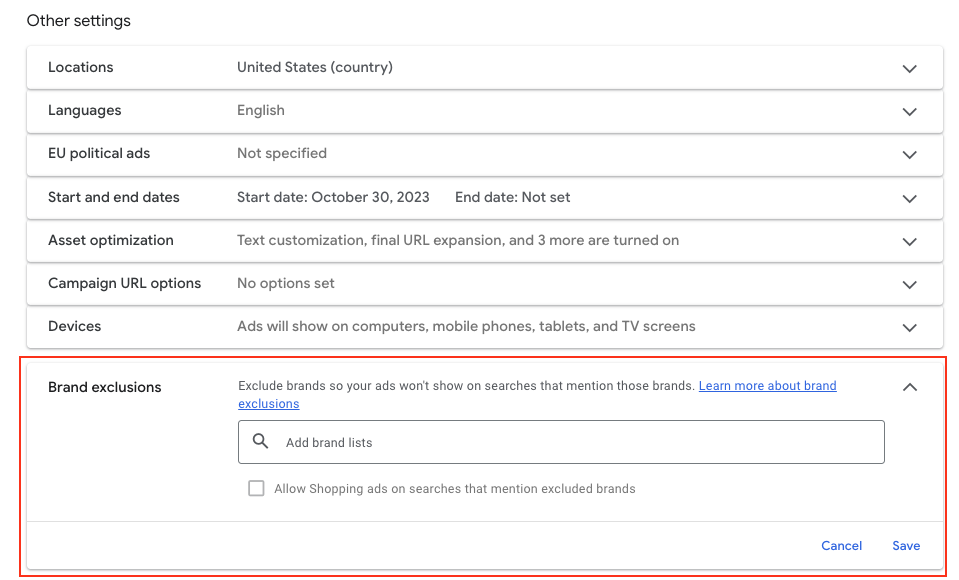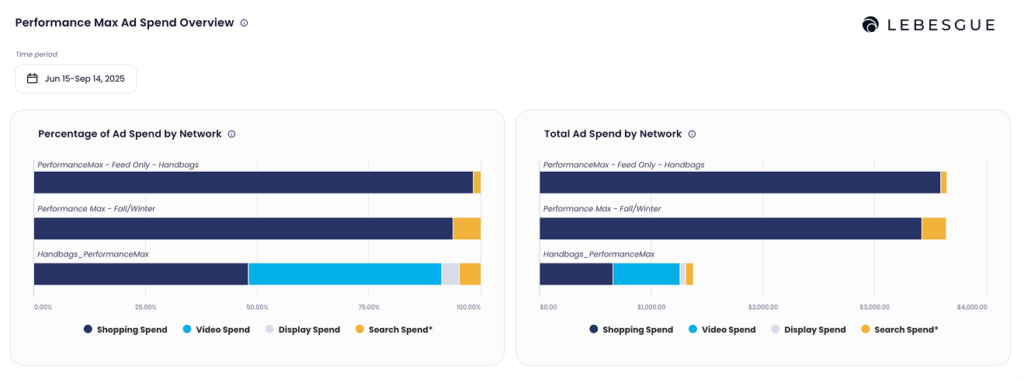Performance Max (PMax) relies on Google’s AI, which means many campaign decisions happen automatically. That can be powerful for scaling, but it also limits how much direct control you have. Left unchecked, PMax often leans too heavily on brand conversions instead of finding new customers.
The good news: you can guide the algorithm. From refining your targeting to improving product feeds and ad assets, small adjustments lead to better clicks, higher conversions, and stronger ROAS.
This guide explains six proven ways eCommerce brands can optimize Performance Max — from excluding brand keywords to monitoring insights — so you scale profitably instead of wasting spend.
What Are Google Performance Max Campaigns?
Performance Max is a goal-based campaign type in Google Ads that gives you access to all of Google’s networks — Search, YouTube, Display, Gmail, and Discover — from a single campaign. Google’s AI handles bidding, targeting, and creative testing, making it easier to scale but harder to control. For eCommerce brands, this balance of automation and limitation is why optimization is essential.
For eCommerce, Performance Max means:
- Faster scale across multiple networks
- Less manual work (automation handles bidding, targeting, and creative testing)
- Higher risk of wasted spend if the system over-indexes on branded searches or irrelevant traffic
That’s why optimization is important. You can’t control everything, but the right levers help steer results toward profitable growth.
So, let’s see easy 6 optimization ways for Performance Max campaigns that can help you grow your e-commerce store.
6 Ways to Optimize Your Performance Max Campaigns
The key to success with PMax isn’t micromanaging the system — it’s guiding it. By focusing on a few strategic levers, you can steer Google’s AI toward new customer acquisition, better product visibility, and higher return on ad spend.
Here are six proven optimization tips for Performance Max we’ll cover:
- Exclude brand keywords to focus on true customer acquisition.
- Apply product and URL exclusions to cut wasted spend.
- Feed the AI stronger ad assets for better performance.
- Adapt creatives to each network (Search, YouTube, Display, Gmail, Discover).
- Optimize your product feed — the foundation of eCommerce success.
- Monitor insights regularly to guide automation without micromanaging.
How can eCommerce brands exclude brand keywords in Performance Max?
One of the most common pitfalls in Performance Max is letting Google spend too much of your budget on branded searches. Branded queries almost always convert — but those shoppers were already planning to buy from you, which means the campaign isn’t really driving new growth.
In the past, you couldn’t exclude brand keywords directly inside a PMax campaign. The workaround was to apply brand exclusions at the account level in Google Ads or to split campaigns — running a dedicated Brand Search campaign while keeping Performance Max focused on non-branded queries.
Now, Google has introduced the ability to exclude brand keywords directly from Performance Max. This makes it easier to control spend, prevent overlap with Search campaigns, and ensure Google’s AI prioritizes finding new customers instead of recycling existing demand.
By excluding branded terms from PMax, you stop the algorithm from leaning on “easy wins” and push it to deliver incremental growth. This keeps reporting accurate, improves return on ad spend, and ensures your budget is focused where it can make the biggest impact.

Our data shows that including branded search keywords inside Performance Max campaigns can hurt results. On average, branded keywords cost 4x more in PMax compared to running them in a standalone Brand Search campaign. This not only increases costs but also reduces incremental conversions, since PMax shifts budget toward brand traffic instead of finding new customers. By excluding brand terms, you allow Google’s AI to focus Performance Max on true growth opportunities.
How should eCommerce brands apply product and URL exclusions in Performance Max?
Not every product in your catalog is worth promoting. Low-margin SKUs, seasonal leftovers, or items with weak performance can eat into your budget if Google continues to show them. The same goes for website pages like clearance or out-of-stock sections — when they’re included in PMax, you risk spending on traffic that doesn’t support your goals.
However, there is a way to avoid showing products you don’t want to advertise. Inside Google Ads, exclude specific products from your listing groups so they don’t appear in PMax. For URLs, use the “final URL expansion” settings to block categories or pages that don’t align with your campaign goals.
By trimming out products and pages that won’t drive profitable sales, you let Google’s AI concentrate on what actually matters: your bestsellers, high-margin products, and new arrivals. That way, PMax works toward profitable growth.

Our data shows that eCommerce brands using product and URL exclusions in Performance Max see measurable improvements. Accounts that exclude low-margin products achieve up to 40% higher ROAS and reduce customer acquisition costs (CAC) by up to 10%. By removing products that don’t contribute to profitability, Google’s AI can focus spend on higher-value items, leading to more efficient campaigns and stronger long-term growth.
How do stronger ad assets improve Performance Max campaigns?
Performance Max can only perform as well as the inputs you provide. Google’s AI builds ads by mixing and matching your headlines, descriptions, images, and videos. If those assets are weak, the algorithm has limited resources to work with, and the campaign will likely underperform.
For eCommerce, go beyond plain product shots. Upload lifestyle images that show products in real use, short product demo videos, and a mix of headlines that highlight both features and benefits. Refresh these assets regularly — especially around seasonal campaigns or product launches — to prevent ad fatigue and give the algorithm new combinations to test.
By supplying PMax with stronger creative inputs, you give the AI more winning options to work with across every network. Feeding Performance Max high-quality, diverse ad assets is one of the fastest ways to improve click-through rates and conversion performance.
Google’s AI can only work with the inputs you provide. When you upload a wide variety of high-quality ad assets — images, videos, headlines, and descriptions — the algorithm has more to test and match with different audiences. According to our data at Lebesgue, campaigns with diverse ad assets achieve up to 20% more conversions, proving that creative variety is one of the easiest ways to improve Performance Max results.
Why should creatives be adapted for each Google network in Performance Max?
Performance Max shows ads across Google’s entire ecosystem: Search, YouTube, Display, Gmail, and Discover. Each of these networks plays a different role in the customer journey, which means the same creative won’t perform equally well everywhere.
For Search and Gmail, focus on clear, conversion-oriented messaging with strong offers and direct calls to action. On YouTube and Display, emphasize visuals and storytelling to build awareness. In Discover, design content that feels native and engaging for mobile-first users.
When your creatives are tailored to the context in which they appear, Google’s AI can deliver more relevant ads and better match intent. Adapting Performance Max creatives to each network ensures that your budget drives results across the full funnel, from awareness through conversion.
Each Google network — Search, YouTube, Display, Gmail, and Discover — reaches users in different contexts. Performance Max works best when creatives are tailored to specific environments, such as using engaging videos for YouTube or clear banners for Display. According to our data, brands that adapt creatives to each Google network see up to 15% lower CPC and up to 10% higher CTR, making tailored assets a direct driver of better efficiency and engagement.
How can eCommerce brands optimize their product feed in Performance Max?
For eCommerce brands, the product feed is the foundation of Performance Max. It tells Google exactly what you sell and helps the algorithm decide when and where to show your products. If the feed is incomplete or inaccurate, even the smartest AI can’t match your products with the right shoppers.
Strong titles and descriptions that mirror real search behavior are essential — think “red linen summer dress” instead of just “dress.” Add attributes like size, color, and material so Google can surface the exact variant a customer is searching for. Use custom labels to flag bestsellers, seasonal products, or high-margin items so you can prioritize budget where it matters most.
A clean, detailed, and regularly updated feed gives Google the context it needs to connect your products with high-intent buyers. Optimizing the product feed in Performance Max is one of the most powerful ways to increase visibility and drive profitable growth.
According to our data at Lebesgue, brands that improve their product feeds see up to 50% higher CTR and up to 30% higher ROAS, proving that feed quality directly impacts campaign performance.
Why is it important to monitor insights regularly in Performance Max?
Performance Max is highly automated, but that doesn’t mean you can leave it completely unattended. Without regular oversight, the algorithm may push spend into placements or products that don’t align with your goals.
The Insights tab in Google Ads gives you visibility into which search terms, products, and networks are driving performance. By reviewing this data, you can spot patterns — like overspending on YouTube impressions or branded queries — and adjust your exclusions, feed, or assets accordingly.
Monitoring insights regularly ensures you’re guiding the AI instead of letting it run unchecked. For eCommerce brands, this is how you turn Performance Max into a consistent driver of profitable growth rather than a budget sink.
Summing Up
Performance Max can be a powerful growth engine for eCommerce, but only if you guide it. Left on autopilot, the algorithm often spends on branded searches, low-value products, or placements that make reports look good without actually driving new customers.
By excluding brand keywords, removing underperforming products and URLs, feeding Google stronger creative assets, tailoring ads to each network, optimizing your product feed, and checking insights regularly, you give the AI the guardrails it needs to perform at its best.
The rule is simple: Performance Max works when you provide the right inputs. Treat it less like a black box and more like a system you can steer, and it will reward you with incremental customers, stronger ROAS, and campaigns that scale profitably. Well-optimized PMax campaigns deliver significantly stronger ROAS compared to default setups.
Performance Max delivers the best results when eCommerce brands actively guide automation with better data, better assets, and smarter exclusions.






